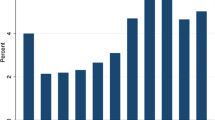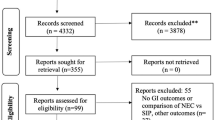Abstract
Objective:
The objective of this study is to determine whether antenatal exposure to magnesium is associated with spontaneous intestinal perforation (SIP) in extremely low birth weight (ELBW) infants (⩽1000 g).
Study Design:
We identified all ELBW infants admitted to 1 of 323 neonatal intensive care units from 2007 to 2013. We used multivariable conditional logistic regression to compare outcomes in the first 21 days after birth between infants exposed and unexposed to magnesium in utero.
Results:
Of the 28 035 infants, 11 789 (42%) were exposed to antenatal magnesium (AM). There was no difference in the risk of SIP, odds ratio=1.08 (95% confidence interval; 0.91 to 1.29), between infants exposed and unexposed to AM. Mortality in the first 21 days after birth was lower in the magnesium-exposed infants, odds ratio=0.76 (0.70 to 0.83).
Conclusion:
AM exposure in ELBW infants was not associated with increased risk of SIP.
This is a preview of subscription content, access via your institution
Access options
Subscribe to this journal
Receive 12 print issues and online access
$259.00 per year
only $21.58 per issue
Buy this article
- Purchase on Springer Link
- Instant access to full article PDF
Prices may be subject to local taxes which are calculated during checkout
Similar content being viewed by others
References
Pryde PG, Mittendorf R . Contemporary usage of obstetric magnesium sulfate: indication, contraindication, and relevance of dose. Obstet Gynecol 2009; 114: 669–673.
Jazayeri A, Jazayeri MK, Sutkin G . Tocolysis does not improve neonatal outcome in patients with preterm rupture of membranes. Am J Perinatol 2003; 20 (4): 189–193.
Rouse DJ, Hirtz DG, Thom E, Varner MW, Spong CY, Mercer BM et al. A randomized, controlled trial of magnesium sulfate for the prevention of cerebral palsy. N Engl J Med 2008; 359 (9): 895–905.
Ramsey PS, Rouse DJ . Magnesium sulfate as a tocolytic agent. Semin Perinatol 2001; 25 (4): 236–247.
Crowther CA, Hiller JE, Doyle LW, Haslam RR . Effect of magnesium sulfate given for neuroprotection before preterm birth: a randomized controlled trial. JAMA 2003; 290 (20): 2669–2676.
Crowther CA, Hiller JE, Doyle LW . Magnesium sulphate for preventing preterm birth in threatened preterm labour. Cochrane Database Syst Rev 2002; (4): CD001060.
Duley L, Gulmezoglu AM, Henderson-Smart DJ, Chou D . Magnesium sulphate and other anticonvulsants for women with pre-eclampsia. Cochrane Database Syst Rev 2010; (11): CD000025.
Marret S, Marpeau L, Follet-Bouhamed C, Cambonie G, Astruc D, Delaporte B et al. [Effect of magnesium sulphate on mortality and neurologic morbidity of the very-preterm newborn (of less than 33 weeks) with two-year neurological outcome: results of the prospective PREMAG trial]. Gynecol Obstet Fertil 2008; 36 (3): 278–288.
Brazy JE, Grimm JK, Little VA . Neonatal manifestations of severe maternal hypertension occurring before the thirty-sixth week of pregnancy. J Pediatr 1982; 100 (2): 265–271.
Jhaveri MK, Kumar SP . Passage of the first stool in very low birth weight infants. Pediatrics 1987; 79 (6): 1005–1007.
Kumar SL, Dhanireddy R . Time of first stool in premature infants: effect of gestational age and illness severity. J Pediatr 1995; 127 (6): 971–974.
Verma A, Dhanireddy R . Time of first stool in extremely low birth weight (< or=1000 grams) infants. J Pediatr 1993; 122 (4): 626–629.
Havranek T, Ashmeade TL, Afanador M, Carver JD . Effects of maternal magnesium sulfate administration on intestinal blood flow velocity in preterm neonates. Neonatology 2011; 100 (1): 44–49.
Cooney DR, Rosevear W, Grosfeld JL . Maternal and postnatal hypermagnesemia and the meconium plug syndrome. J Pediatr Surg 1976; 11 (2): 167–172.
Rattray BN, Kraus DM, Drinker LR, Goldberg RN, Tanaka DT, Cotten CM . Antenatal magnesium sulfate and spontaneous intestinal perforation in infants less than 25 weeks gestation. J Perinatol 2014; 34 (11): 819–822.
Gordon PV, Clark R, Swanson JR, Spitzer A . Can a national dataset generate a nomogram for necrotizing enterocolitis onset? J Perinatol 2014; 34 (10): 732–735.
Donahue L . Spontaneous intestinal perforation. Neonat Netw 2007; 26 (5): 335–351.
Kawase Y, Ishii T, Arai H, Uga N . Gastrointestinal perforation in very low-birthweight infants. Pediatr Int 2006; 48 (6): 599–603.
Attridge JT, Herman AC, Gurka MJ, Griffin MP, McGahren ED, Gordon PV . Discharge outcomes of extremely low birth weight infants with spontaneous intestinal perforations. J Perinatol 2006; 26 (1): 49–54.
Shah TA, Meinzen-Derr J, Gratton T, Steichen J, Donovan EF, Yolton K et al. Hospital and neurodevelopmental outcomes of extremely low-birth-weight infants with necrotizing enterocolitis and spontaneous intestinal perforation. J Perinatol 2011; 32 (7): 552–558.
Payne AH, Hintz SR, Hibbs AM, Walsh MC, Vohr BR, Bann CM et al. Neurodevelopmental outcomes of extremely low-gestational-age neonates with low-grade periventricular-intraventricular hemorrhage. JAMA Pediatr 2013; 167 (5): 451–459.
Beaino G, Khoshnood B, Kaminski M, Pierrat V, Marret S, Matis J et al. Predictors of cerebral palsy in very preterm infants: the EPIPAGE prospective population-based cohort study. Dev Med Child Neurol 2010; 52 (6): e119–e125.
O'Shea TM, Allred EN, Kuban KC, Hirtz D, Specter B, Durfee S et al. Intraventricular hemorrhage and developmental outcomes at 24 months of age in extremely preterm infants. J Child Neurol 2012; 27 (1): 22–29.
Vermeulen GM, Bruinse HW, de Vries LS . Perinatal risk factors for adverse neurodevelopmental outcome after spontaneous preterm birth. Eur J Obstet Gynecol Reprod Biol 2001; 99 (2): 207–212.
Basu SK, Chickajajur V, Lopez V, Bhutada A, Pagala M, Rastogi S . Immediate clinical outcomes in preterm neonates receiving antenatal magnesium for neuroprotection. J Perinat Med 2011; 40 (2): 185–189.
Elimian A, Verma R, Ogburn P, Wiencek V, Spitzer A, Quirk JG . Magnesium sulfate and neonatal outcomes of preterm neonates. J Matern Fetal Neonatal Med 2002; 12 (2): 118–122.
Mittendorf R, Covert R, Boman J, Khoshnood B, Lee KS, Siegler M . Is tocolytic magnesium sulphate associated with increased total paediatric mortality? Lancet 1997; 350 (9090): 1517–1518.
Acknowledgements
Sponsors had no involvement in the study design, the collection, analysis and interpretation of data, the writing of the report, nor the decision to submit the manuscript for publication.
Author information
Authors and Affiliations
Corresponding author
Ethics declarations
Competing interests
CPH receives salary support for research from the National Center for Advancing Translational Sciences of the National Institutes of Health (UL1TR001117). ML is supported by the US government for his work in pediatric and neonatal clinical pharmacology (HHSN267200700051C (Principal Investigator: Benjamin)), National Institute of Child Health and Human Development (K23 HD068497) and the National Heart, Lung, and Blood Institute (R34 HL124038). PBS receives salary support for research from the National Institutes of Health (NIH) and the National Center for Advancing Translational Sciences of the NIH (1R21HD080606-01A1 and UL1TR001117), the National Institute of Child Health and Human Development (HHSN275201000003I and 1R01-HD081044-01) and the Food and Drug Administration (1R18-FD005292-01); he also receives research support from Cempra Pharmaceuticals (subaward to HHS0100201300009C) and industry for neonatal and pediatric drug development (www.dcri.duke.edu/research/coi.jsp). All other authors declare no conflicts of interest.
Rights and permissions
About this article
Cite this article
Downey, L., Cotten, C., Hornik, C. et al. Association of in utero magnesium exposure and spontaneous intestinal perforations in extremely low birth weight infants. J Perinatol 37, 641–644 (2017). https://doi.org/10.1038/jp.2016.274
Received:
Revised:
Accepted:
Published:
Issue Date:
DOI: https://doi.org/10.1038/jp.2016.274
This article is cited by
-
Risk factors and epidemiology of spontaneous intestinal perforation among infants born at 22–24 weeks’ gestational age
Journal of Perinatology (2024)
-
Antenatal Magnesium Sulfate and adverse gastrointestinal outcomes in Preterm infants—a systematic review and meta-analysis
Journal of Perinatology (2023)
-
Antenatal magnesium sulfate treatment and risk of necrotizing enterocolitis in preterm infants born at less than 32 weeks of gestation
Scientific Reports (2020)



